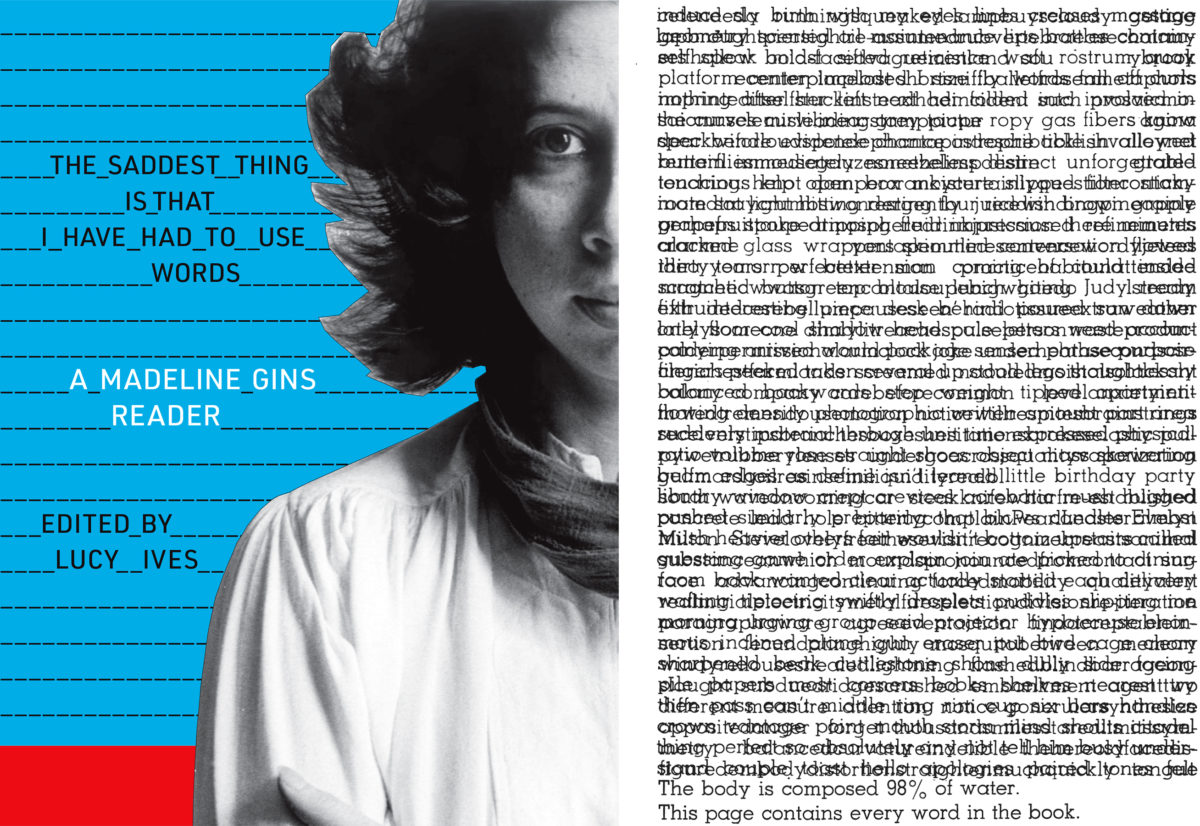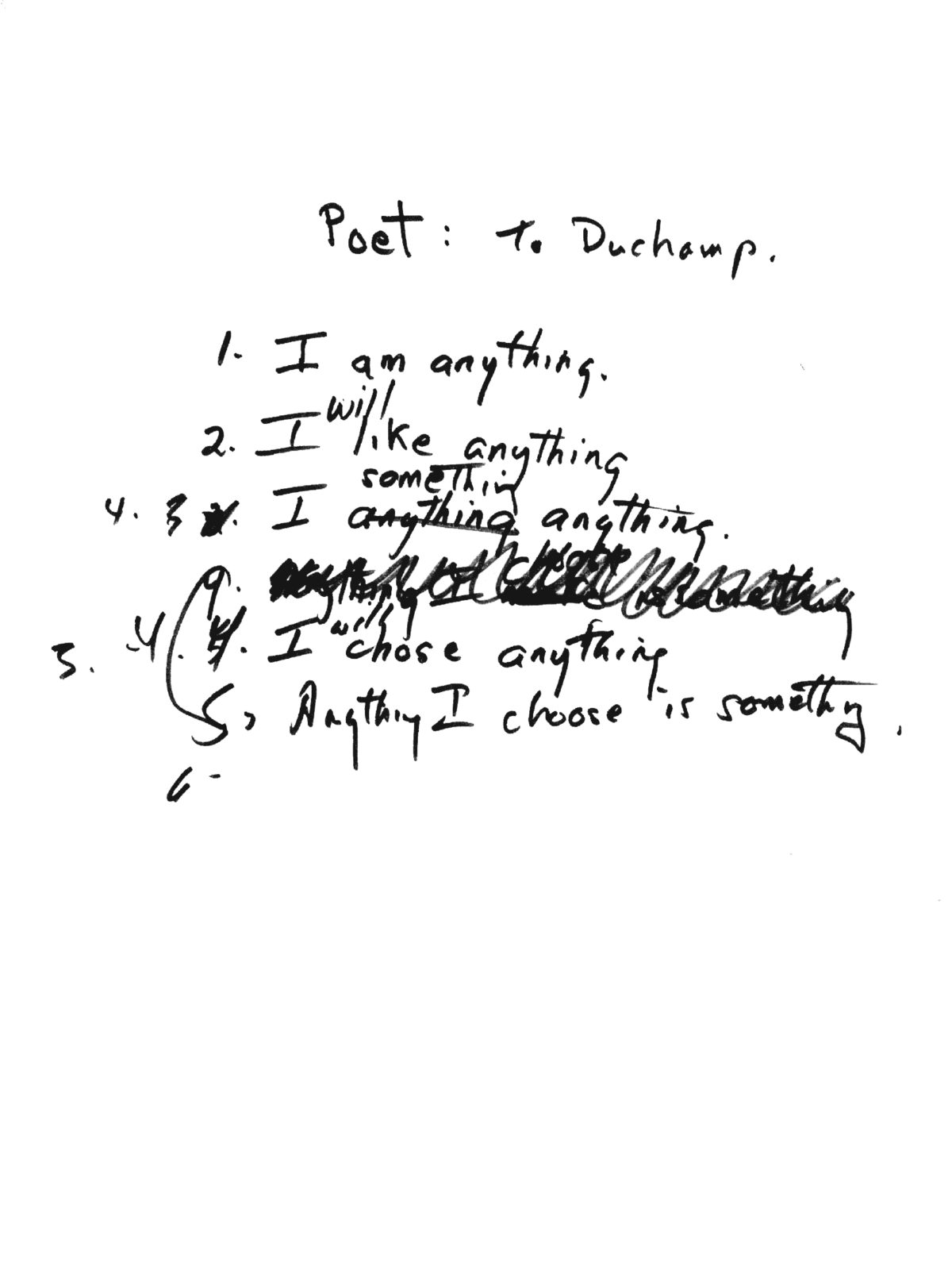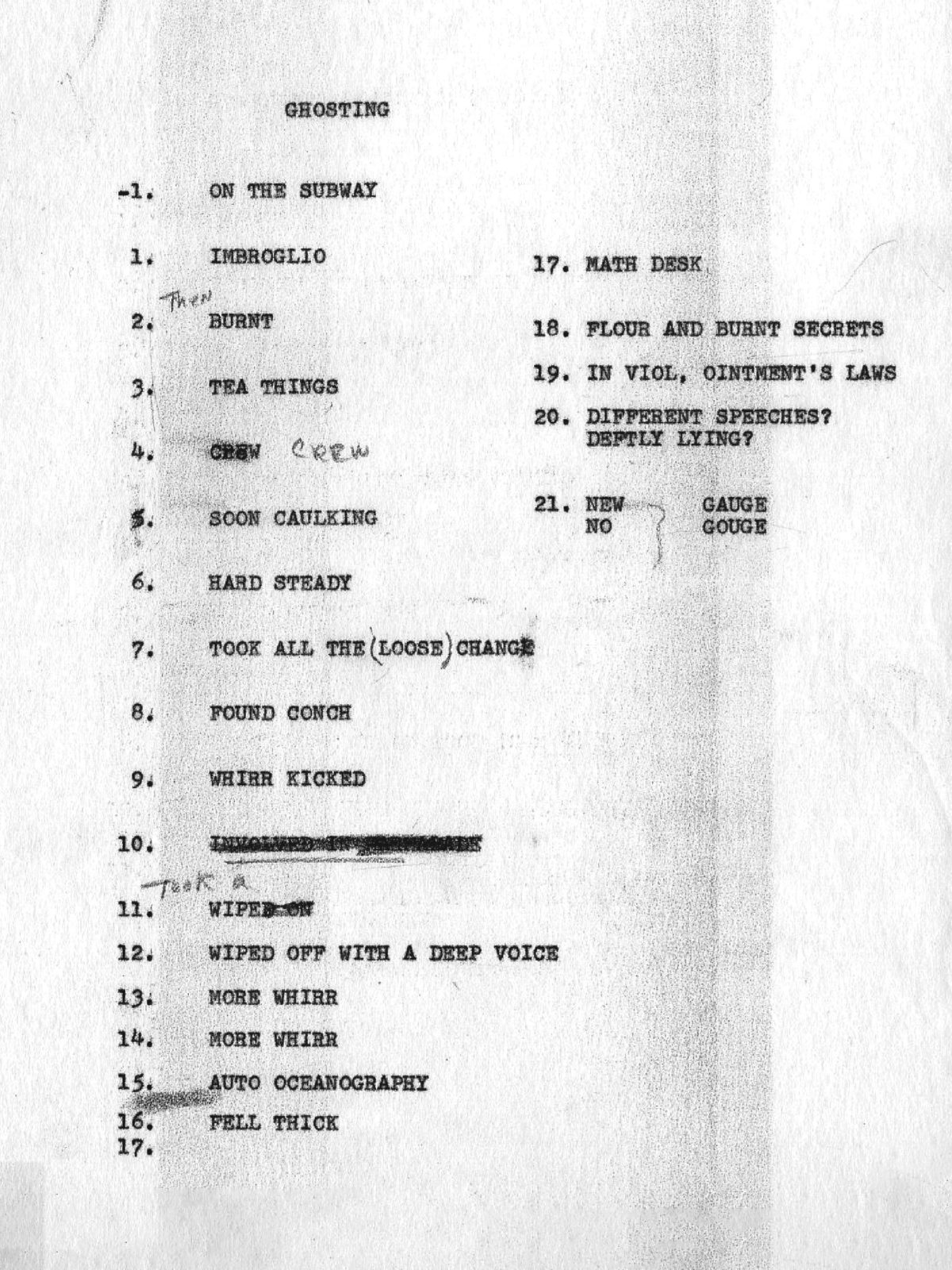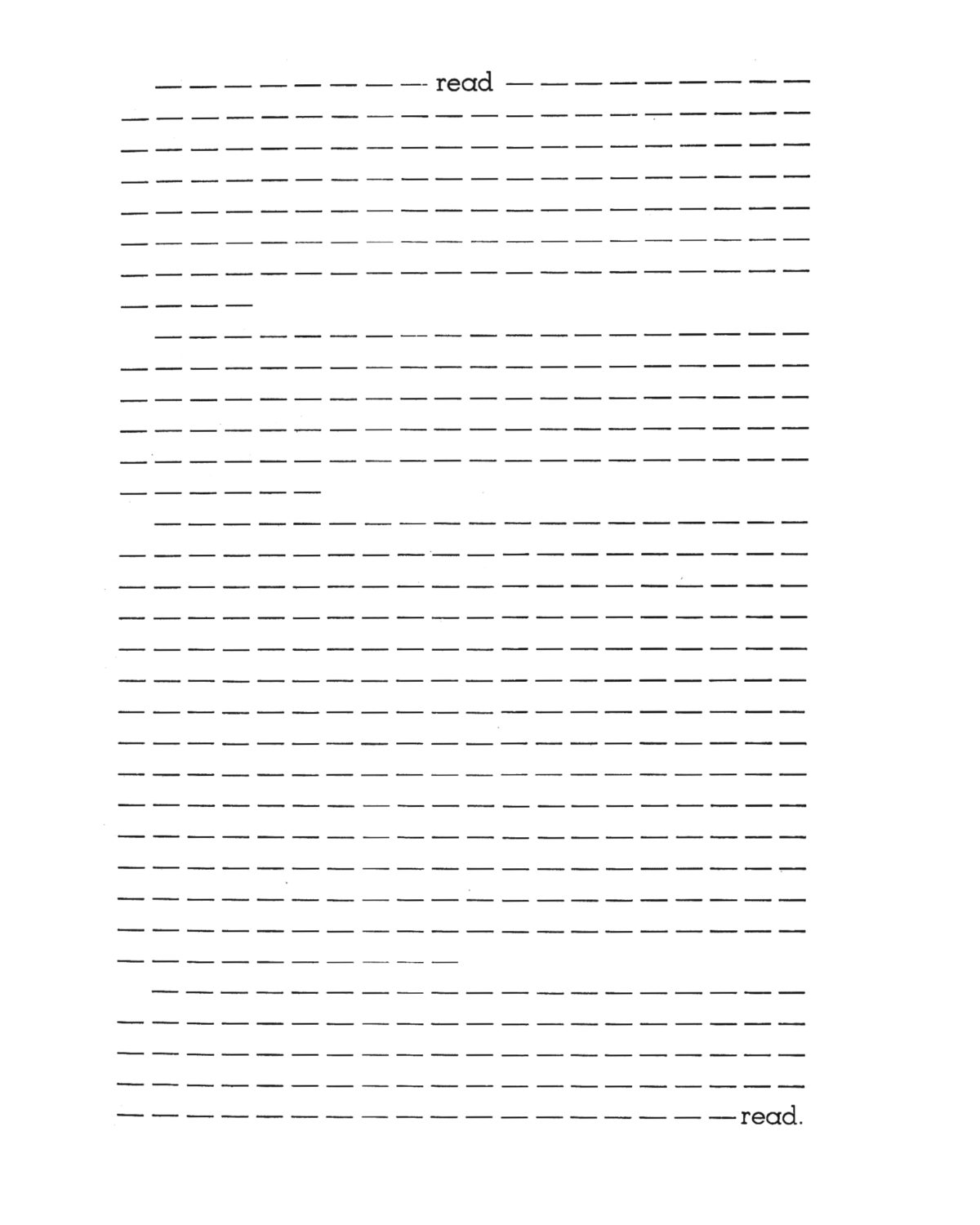
Several months ago I received a review copy of The Saddest Thing Is That I Have Had to Use Words: A Madeline Gins Reader, an extensive archive of the artist and writer’s published and unpublished poems, prose, and experimentations, edited by the poet Lucy Ives and published by Siglio Press. Lucy and I agreed to a podcast interview recorded at a scaled model of Gins’ Reversible Destiny “procedural architecture” anti-aging installation—the Biotopological Scale-Juggling Escalator at the Dover Street Market in New York City. Then New York City went into lockdown. So we adjusted our plans. To pay homage to Gins, an artist, philosopher, and writer of the L A N G U A G E poem and avant-garde ilk (though I’m sure she’d eschew the distinctions), we turned the interview into a game.
Situated near the end of the anthology is the essay “How to Breathe,” which inspired this call-and-response style interview. “How to Breathe” resonates in so many obvious ways. Gins’ instructions for taking a literal breath can be read as a figural metaphor for the act of writing and editing. So, I took (most all of the) words from Gins’ list (see below) and repurposed them as questions for Lucy about her process, writing, and editing.
Gins’ list:
- Selection
- Path of Entrance
- Determining of length: a) generating of appropriate anatomical readiness; b) bearing appropriate dimensions
- Sucking
- Propagation of sucking
- Electrical flow
- Entering and expanding
- Spreading
- Attaching
- Applying
- Rejecting
- Collapsing
- Inviting pressure play
Below you’ll find each word from this list hidden in the question and answers.
—Meg Whiteford
THE BELIEVER: How did you select these works? How were you selected for the project?
LUCY IVES: I selected these works from Madeline Gins’ archive. It’s located in lower Manhattan at the Reversible Destiny Foundation, an artists’ foundation named for the collaborative architectural project Gins developed with her husband, Arakawa. I started visiting the archive for another publication project related to the architectural work and became interested in the unpublished poetry, and things sort of went from there.
I didn’t originally go to the archive thinking that there was so much wonderful writing by Gins still unpublished; I had no idea—an important lesson, I suppose, in itself. In sorting through Gins’ early writing over several years I did have the uncanny experience of feeling older work begin to “fit” the present, if that makes any sense. When I first began my research, I wasn’t sure how what I was finding would be read, in the present, but it began to seem more and more legible and funny and pleasurable as I went on, as if it might sort of be expanding to meet the contemporary moment. By the time I was working on a draft of the collection, it was clear to me that this writing might be more widely legible now than it would have been in 1970, for example. As I say, this was an uncanny feeling, because I felt not just the oddness of work being out of place in its own time, but the oddness of it coming to be in place in another time.
I think this is what archives are for, to permit these sorts of returns and displacements. I’m not sure what a record is, precisely (of course, I know the dictionary definition); however, publicness, at least with respect to archives and memory, seems to have to do with a certain porousness and flexibility, an ability to reincorporate lost or rejected elements, to continually expand our conceptions of what has value.
BLVR: What was your path of entrance to Madeline Gins?
LI: I first came across Gins’ work less than a year after I graduated from college, when I was just beginning an MFA in poetry. It is interesting to me to look back now on that time. I wonder if there isn’t something of a time loop going on, where, in the past, I sense that in the future I will come back to this work. That’s in my memory of that time, at least, weirdly enough, this premonition or intimation—and seems relevant to Gins’ ideas about how reading and writing work.

From The Saddest Thing Is That I Have Had to Use Words: A Madeline Gins Reader (Siglio, 2020).
BLVR: How did you determine the shape of the book would include graphic texts?
LI: Gins’ most experimental and brilliant work, the writing from the late 1960s and 70s, has some of the hallmarks of that period in visual art circles in New York—and of the writing that was part of conceptualism. There’s some interest in the task as form as well as the activated space between the reader and the page. This said, Gins’ take on these matters is entirely her own. If the central cliché of avant-garde-ism is novelty for the sake of novelty, innovation for the sake of being able to claim (often in an academic context) “I have innovated!” then I doubt Gins succumbs to that sort of cliché. Her work is so odd and so particular that its oddness, as such, is obviously unstudied and an expression of a genuine intellectual and emotional situation.
BLVR: Has her work influenced, been sucked into, your writing?
LI: Working on someone else’s writing, particularly when there is a lot of it, takes up a fair amount of mental space. I had learned while I was getting my PhD that an important technique when one is working in an archive is to return: essentially, you’re going to remember what you saw one way, but when you go back, that material is going to look completely different. I’m afraid I must confirm that this is indeed the case. And it might be that there is something about unpublished literary writing that makes it particularly subject to unconscious alteration and projection. So I may have looked at the same sequence of thirty or so pages five times or more, in trying to figure out what I thought about it. I think the staff at the foundation wondered what I was doing sometimes! Regarding my own work, I really can’t say. I’ve always been very interested in unusual styles of description; this is an affinity I share with Gins.
BLVR: Have you ever achieved the ideal state of flow?
LI: I don’t think I ever achieved any ideal states! But states of absorption are just about my favorite thing, which is why I think I wanted to spend my life reading and writing. And another reason why I find Gins’ writing so interesting. It really takes you somewhere else.
BLVR: Once inside, where were the points you identified for expansion and how did you expand? How, if at all, did working on this book expand you?
LI: I think that this book allowed me to expand upon an idea of Gins I know many readers of the further reaches of American poetry might already have had, as well, which is to say: I was able to expand upon her independent identity as a highly skilled and innovative writer.
Before Gins began working so concertedly collaboratively—which is to say, before she became somewhat subsumed within the Reversible Destiny project—she had unique concerns and methods as an experimental writer. I think her early work is often in dialogue with Arakawa’s, but there is an important distance between them that gets a bit collapsed later on. I’m not sure how much attention Gins’ writing received when it was first published, and perhaps it was difficult to continue on as an independent author in those conditions. I really don’t know. What I do know is that this work is just utterly surprising and brilliant, and I am excited that more people will get to experience it.

From The Saddest Thing Is That I Have Had to Use Words: A Madeline Gins Reader (Siglio, 2020).
BLVR: Was there any moment you felt her works were spreading out of control?
LI: There were times when I was photographing pages in the archive and would have over 200 images on my phone from an afternoon’s work that I did feel the quantity of the work testing and often exceeding my ability to comprehend it visually and technologically. I think there are ethical questions regarding what one should or may do with a given archive that are more palpable when that archive is very large, because one sees more clearly how one’s own subjectivity is informing the shape one gives to the material one selects for study or publication. In a way, I did enjoy this seeming infinity, the out-of-control-ness of the archive. It would have been sad if it seemed like the archive was meager or not much had made it in (i.e., a lot was missing). The fact is, Gins preserved some very stylish early work that she did not publish. I’m not sure what her orientation to my excitement about it would have been, but that she did not destroy it suggests she herself believed it had some merit.
BLVR: What did you attach to the project of your own background, as a poet, novelist, a person?
LI: I thought a lot about the first time I read the collection of Hannah Weiner’s writing edited by Patrick Durgin, Hannah Weiner’s Open House, and how I had felt that that book was so fitting and beautiful and calm, just such a serene compilation of a form of American thought that I so desired and needed. Even as I understood that Weiner had struggled to make her work during her lifetime, this book established a sense of Weiner’s style and experiment that seemed to push beyond all the possible claims against Weiner’s “impossible” visions and writing. Now, in 2020, I think Weiner is seen as an artist and speculative media theorist, as well as as a poet; we understand that she was attempting to grasp major technological transformations that lay ahead. I felt similarly when I read the edition of Jack Spicer’s work that was edited by Peter Gizzi and Kevin Killian, My Vocabulary Did This to Me, which came out two years after the Weiner collection, in 2008. I attached these memories of reading crucial edited collections to my work on this project. I thought about the difference that these two books had made to me, which was a very big difference, indeed.
BLVR: What did you reject in the collection?
LI: The book is pretty thick. We put a lot in and were glad about that. I’m not sure that at the moment I would change anything. However, in another year I’ll almost certainly have a different answer for you.
BLVR: What was it like, collapsing her disperse work into a coherent book?
LI: I think I didn’t know until the book was very nearly finalized that it was all working together. In prioritizing certain selections, I was working from a sense of where you could see Gins’ various strategies most clearly—thinking about, What if this were a manual to teach you how to write like Madeline Gins? What would you need to know, to see? Which pieces of writing would be most helpful? What would be most surprising? So this was how I put things together. It means that work from the archive and her 1969 experimental novel WORD RAIN were going to have pride of place. But then, at the very end, everything just came together. The book shows Gins in a new way, but it’s very much Gins—sempre Gins, to paraphrase Sigrid Nunez in a silly way. Maybe it’s a sort of supercharged version of Gins’ work, as here so much of it is, in one place.

BLVR: Madeline’s work seems so playful to me, really using language and letters and grammar as toys. How did you invite play into the book and its process?
LI: The book itself is a very fun object, flexible but sturdy, with a colorful cover and flaps. I’ve taken mine all over the place and it still looks great and good as new; I’m definitely not precious with it (and I really hate it when books fall apart fast). Beyond this (potentially shallow observation), as you may have noticed, Gins’ work has a lot of blanks in it, and I’ve seen people scanning or xeroxing some poems and a questionnaire that I included in the introduction and using these materials to generate new writing. That’s a really delightful outcome that I hadn’t quite foreseen, nerd that I am! So I’m very glad that so much of the experimental work made it in; this turns out, paradoxically/not paradoxically, to be some of the more accessible parts of the book. I recently saw a tweet from someone who had given her kids Gins’ poem “Ode to This,” which has many blanks in it, to fill out. They wrote some great things about an octopus and a llama.
BLVR: What is breathing? And, what is writing?
LI: Those are tough questions!
BLVR: Scratch that, lastly lastly, please fill in the blanks.
LI: Take a running breath and leap into _blank_.
Breathing is just like _Madeline_.




